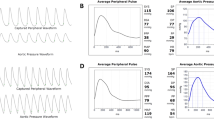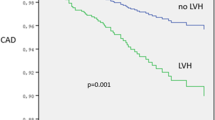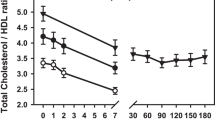Abstract
Heart-type fatty acid-binding protein (H-FABP), a marker of acute myocardial infarction and a soluble cytosolic protein, may be released following left ventricular remodelling in cardiac overloaded hearts caused by hypertension, aortic regurgitation (AR) or aortic stenosis (AS). Our aim was to investigate if H-FABP levels are associated with left ventricular remodelling and clinical outcome in hypertensive patients with AR or AS. H-FABP and brain natriuretic peptide (BNP) were measured, glomerular filtration rate (GFR) was estimated using the modification of diet in renal disease (MDRD) equation, and left ventricular dimension at systole corrected for body surface area (LVDs/BSA) and relative wall thickness (RWT) were determined by echocardiography in hypertensive patients with mild-to-moderate AR (n=78), those with mild-to-moderate AS (n=73) and those without valvular heart diseases (HT) (n=50). H-FABP levels were significantly higher in AR (4.9±3 ng/ml) and in AS (4.5±3) than in HT (3.4±1) and BNP (65±73 pg/ml, 76±75, 35±22). H-FABP correlated with LVDs/BSA in AR (β=0.23, P<0.05), and RWT in AS (β=0.18, P<0.05) after adjustment for age, gender and all the other variables. AS and AR patients were prospectively followed up for cardiac events during 34±19 months. A multivariate Cox hazard analysis indicated H-FABP was an independent predictor of outcome both in AR (relative risk (RR)=7.61, 95% CI=2.39–25.3) and AS (RR=13.6, 95% CI=3.27–66.9). H-FABP, associated with left ventricular remodelling, is useful in predicting clinical outcome in hypertensive patients with mild-to-moderate aortic valve diseases.
This is a preview of subscription content, access via your institution
Access options
Subscribe to this journal
Receive 12 digital issues and online access to articles
$119.00 per year
only $9.92 per issue
Buy this article
- Purchase on Springer Link
- Instant access to full article PDF
Prices may be subject to local taxes which are calculated during checkout


Similar content being viewed by others
References
Glatz JF, van der Vusse GJ, Simoons ML, Kragten JA, van Dieijen-Visser MP, Hermens WT . Fatty acid-binding protein and the early detection of acute myocardial infarction. Clin Chim Acta 1998; 272: 87–92.
Setsuta K, Seino Y, Ogawa T, Arao M, Miyatake Y, Takano T . Use of cytosolic and myofibril markers in the detection of ongoing myocardial damage in patients with chronic heart failure. Am J Med 2002; 113: 717–722.
Pelsers MM, Hermens WT, Glatz JF . Fatty acid-binding proteins as plasma markers of tissue injury. Clin Chim Acta 2005; 352: 15–35.
Rosenhek R, Klaar U, Schemper M, Scholten C, Heger M, Gabriel H et al. Mild and moderate aortic stenosis. Natural history and risk stratification by echocardiography. Eur Heart J 2004; 25: 199–205.
Antonini-Canterin F, Huang G, Cervesato E, Faggiano P, Pavan D, Piazza R et al. Symptomatic aortic stenosis: does systemic hypertension play an additional role? Hypertension 2003; 41: 1268–1272.
Kontos J, Papademetriou V, Wachtell K, Palmieri V, Liu JE, Gerdts E et al. Impact of valvular regurgitation on left ventricular geometry and function in hypertensive patients with left ventricular hypertrophy: the LIFE study. J Hum Hypertens 2004; 18: 431–436.
Cohn JN, Ferrari R, Sharpe N . Cardiac remodeling – concepts and clinical implications: a consensus paper from an international forum on cardiac remodeling. Behalf of an International Forum on Cardiac Remodeling. J Am Coll Cardiol 2000; 35: 569–582.
Carabello BA . Concentric versus eccentric remodeling. J Card Fail 2002; 8: S258–S263.
Rossi A, Tomaino M, Golia G, Anselmi M, Fuca G, Zardini P . Echocardiographic prediction of clinical outcome in medically treated patients with aortic stenosis. Am Heart J 2000; 140: 766–771.
Komamura K, Sasaki T, Hanatani A, Kim J, Hashimura K, Ishida Y et al. Heart-type fatty acid binding protein is a novel prognostic marker in patients with non-ischaemic dilated cardiomyopathy. Heart 2006; 92: 615–618.
Morioka N, Shigematsu Y, Hamada M, Higaki J . Circulating levels of heart-type fatty acid-binding protein and its relation to thallium-201 perfusion defects in patients with hypertrophic cardiomyopathy. Am J Cardiol 2005; 95: 1334–1337.
Ricchiuti V, Zhang J, Apple FS . Cardiac troponin I and T alterations in hearts with severe left ventricular remodeling. Clin Chem 1997; 43: 990–995.
Azzazy HM, Pelsers MM, Christenson RH . Unbound free fatty acids and heart-type fatty acid-binding protein: diagnostic assays and clinical applications. Clin Chem 2006; 52: 19–29.
Fischer TA, McNeil PL, Khakee R, Finn P, Kelly RA, Pfeffer MA et al. Cardiac myocyte membrane wounding in the abruptly pressure-overloaded rat heart under high wall stress. Hypertension 1997; 30: 1041–1046.
Bekeredjian R, Grayburn PA . Valvular heart disease: aortic regurgitation. Circulation 2005; 112: 125–134.
Gerber IL, Legget ME, West TM, Richards AM, Stewart RA . Usefulness of serial measurement of N-terminal pro-brain natriuretic peptide plasma levels in asymptomatic patients with aortic stenosis to predict symptomatic deterioration. Am J Cardiol 2005; 95: 898–901.
Gerber IL, Stewart RA, Legget ME, West TM, French RL, Sutton TM et al. Increased plasma natriuretic peptide levels reflect symptom onset in aortic stenosis. Circulation 2003; 107: 1884–1890.
Nessmith MG, Fukuta H, Brucks S, Little WC . Usefulness of an elevated B-type natriuretic peptide in predicting survival in patients with aortic stenosis treated without surgery. Am J Cardiol 2005; 96: 1445–1448.
Weber M, Arnold R, Rau M, Elsaesser A, Brandt R, Mitrovic V et al. Relation of N-terminal pro B-type natriuretic peptide to progression of aortic valve disease. Eur Heart J 2005; 26: 1023–1030.
Lim P, Monin JL, Monchi M, Garot J, Pasquet A, Hittinger L et al. Predictors of outcome in patients with severe aortic stenosis and normal left ventricular function: role of B-type natriuretic peptide. Eur Heart J 2004; 25: 2048–2053.
Hillege HL, Girbes AR, de Kam PJ, Boomsma F, de Zeeuw D, Charlesworth A et al. Renal function, neurohormonal activation, and survival in patients with chronic heart failure. Circulation 2000; 102: 203–210.
Author information
Authors and Affiliations
Corresponding author
Rights and permissions
About this article
Cite this article
Iida, M., Yamazaki, M., Honjo, H. et al. Predictive value of heart-type fatty acid-binding protein for left ventricular remodelling and clinical outcome of hypertensive patients with mild-to-moderate aortic valve diseases. J Hum Hypertens 21, 551–557 (2007). https://doi.org/10.1038/sj.jhh.1002195
Received:
Revised:
Accepted:
Published:
Issue Date:
DOI: https://doi.org/10.1038/sj.jhh.1002195
Keywords
This article is cited by
-
An update of new/potential cardiovascular markers: a narrative review
Molecular Biology Reports (2024)
-
Clinical Implications of Serum Biomarkers of Cardiac Stress in Aortic Stenosis
Current Heart Failure Reports (2018)
-
Point-of-care test of heart-type fatty acid-binding protein for the diagnosis of early acute myocardial infarction
Acta Pharmacologica Sinica (2010)



